Expert’s Rating
Pros
- Fast and maneuverable
- Edge cleaning
- Self-cleaning program
- Vacuum and mop in one sweep
Cons
- Can’t steam or sanitize
- Rollers need to be replaced after 25 hours of cleaning
- Expensive
Our Verdict
What the WashG1 does, it does very well. If you have a lot of sealed, hard flooring in your home, it’ll save you from having to vacuum and mop separately–and it will do both quickly, and to a high standard. But its high price means that it won’t be a realistic mop replacement for most people.
Price When Reviewed
$699.99 (not yet available in the U.S., expected fall 2024)
The WashG1 is Dyson’s first dedicated hard flooring cleaner for wet and dry spills and debris. You can use it on vinyl, laminate, tile, and sealed wood flooring. As you’d expect, you can’t use it as a carpet cleaner.
What sets it apart from many rivals is that you don’t need to vacuum and mop separately: the WashG1 will do both. It also works in a completely different way to most wet vacuums. Instead of using direct suction to pull dirty water and debris from the floor, its counter-rotating twin rollers soak it up and flick debris into a tray, while a small pump pulls dirty water into the tank.
Dyson believes that this is a more efficient way of doing things, and one that will result in far fewer clogs and no need for a stinky debris filter in the machine.
Read on to see how the WashG1 performed in our test, and check out our round-up of the best wet and dry vacuums to see how it measures up against the competition.
The WashG1’s cleaning power was seriously impressive.
Design and build
- Three water levels and a boost button
- 1-litre clean and dirty water tanks
- Digital display
The WashG1 is a little more subdued in its color palette than many Dyson machines–not a bad thing, in my opinion. It has a matte black body and matching cleaning head. Its royal blue metal wand curves up to support a compact digital display and comfortable handle.

Emma Rowley / Foundry
Its design is simple, with clear, 1-liter clean and dirty water tanks on the outside, and easy-to-remove soft rollers and debris tray. Between the open design, and the fact that debris and hair don’t actually enter the machine, there are far fewer opportunities for anything to get jammed inside it.
The WashG1 comes with a compact (11.8 x 8.9 inches), tray-like, black charging base that snugly fits the cleaner, so it’s fairly easy to find a spot to stand it next to a plug.
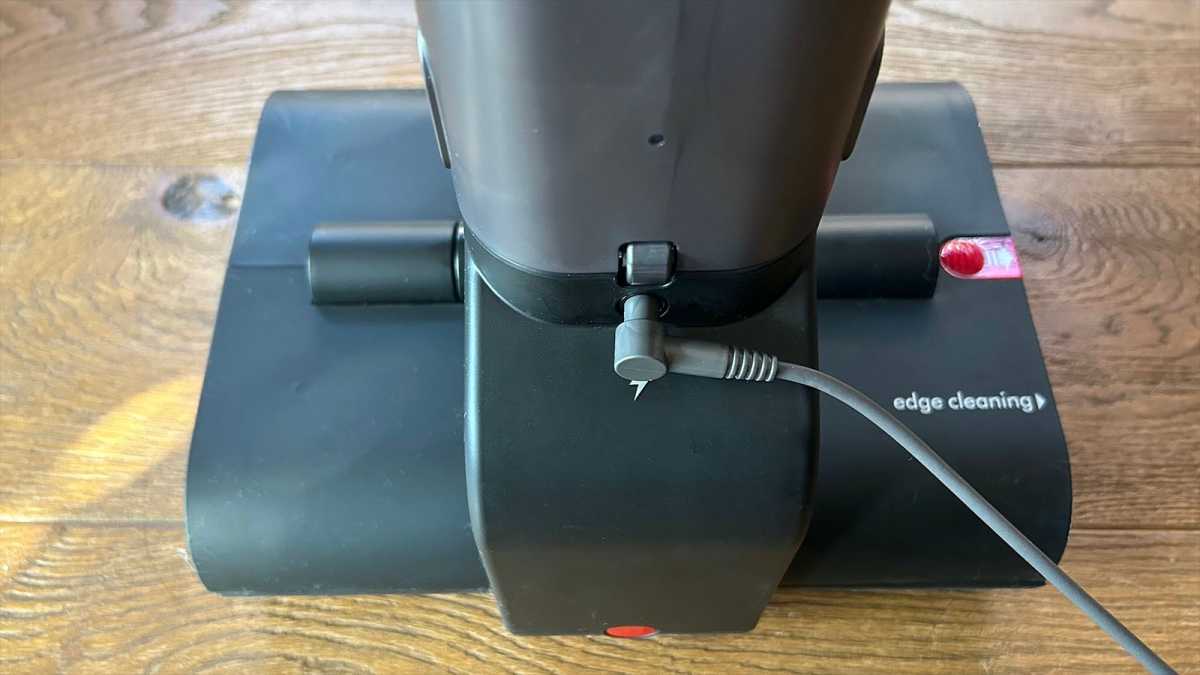
Emma Rowley / Foundry
In a clever bit of design, the water tanks pop off together, so you can empty and fill them in one go. Each tank has a screw-on lid, so there’s no danger of spills when carrying them.
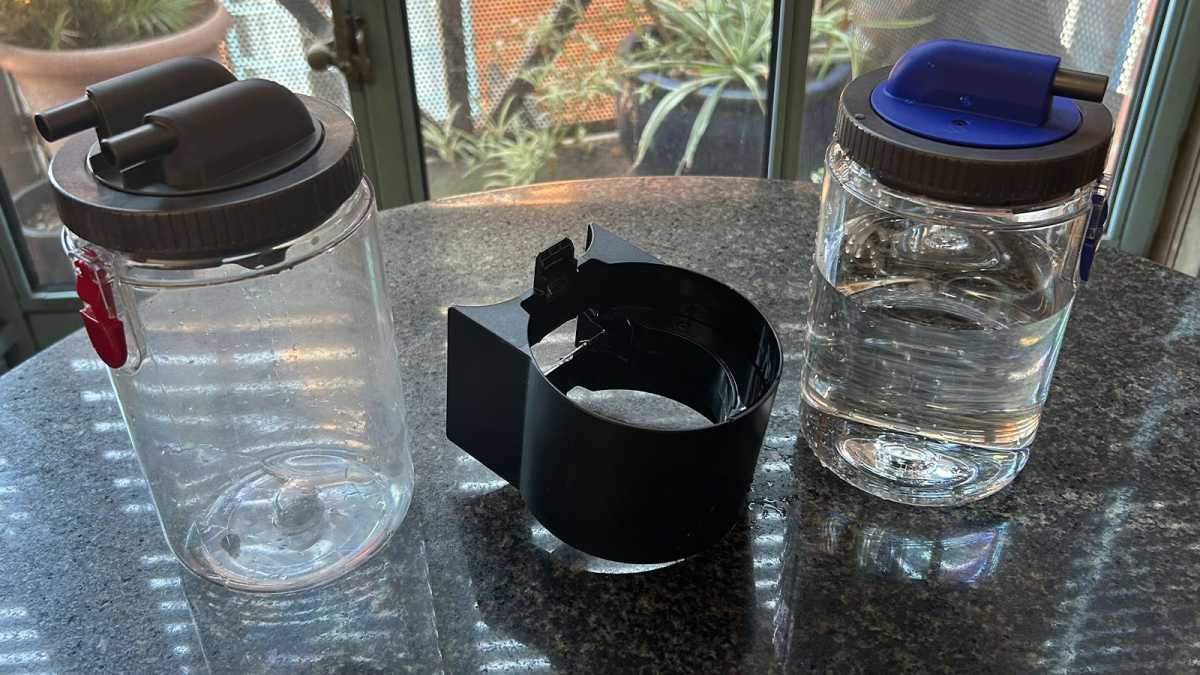
Emma Rowley / Foundry
The controls are as straightforward as the rest of the design. There are three buttons above a round digital display: the power switch, a button to cycle between the three water settings and access other menu items (you can change the language and see how much life your roller has left, for example), and a water boost button, to tackle extra-sticky spills.
The digital display shows the water level–illustrated by water droplets–and the cleaning time remaining. On the low setting, you should get 35 minutes of mopping time.
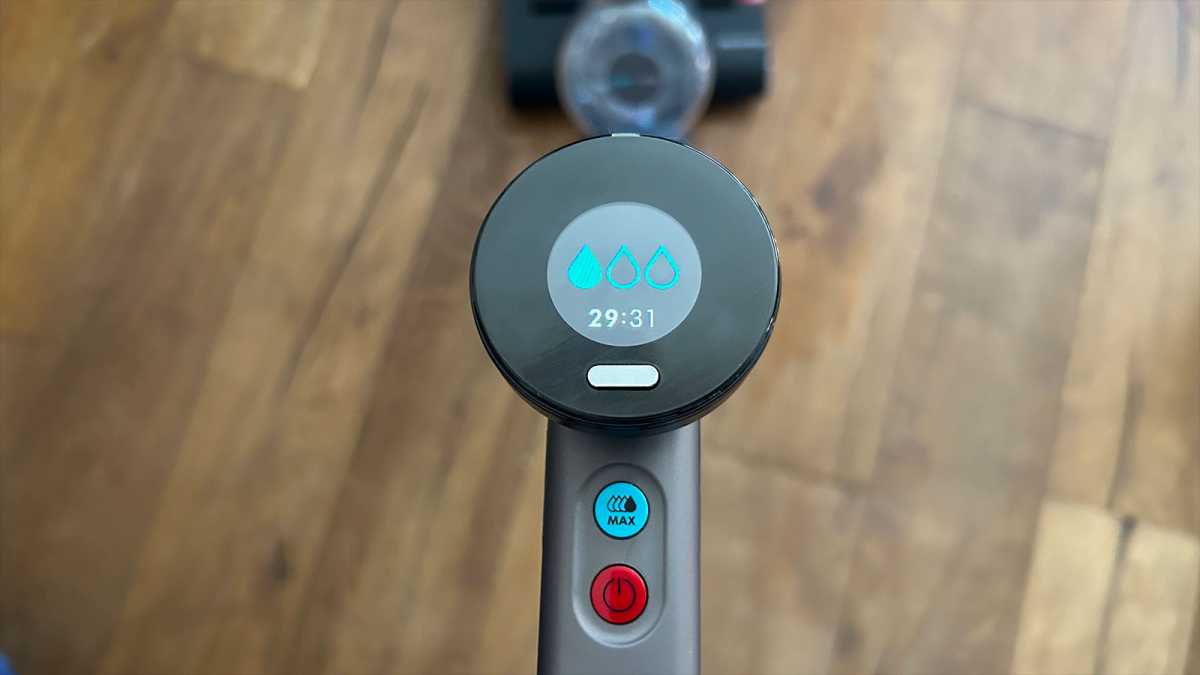
Emma Rowley / Foundry
It’s worth mentioning that you’re likely to run out of water before the battery needs recharging, so water is the key limiting factor. Still, Dyson reckons that a full clean water tank will let you clean up to 3,100 square feet (presumably on the lowest water setting), which means it could comfortably clean a tennis court in one go.
As I don’t have an entire tennis court to clean, I couldn’t test that limit, but what I can say is that I cleaned my bedroom, kitchen, and bathroom floors to a shine on around half a tank of water.
The machine is boxed up in all-recyclable packaging and it’s quick and easy to put together. All you’ll need to do is attach the wand to the vacuum body, plug the cable into the charging base and stand the WashG1 on it to charge.
There are no smart features to worry about.
Performance and features
- Edge cleaning on one side
- Good for cleaning under furniture
- Can’t get right into corners
Before I tested the WashG1, I didn’t mop my floors for a couple of weeks to give the cleaner a proper test. (That’s my story, and I’m sticking to it.) But, the day before using it, I ran the robot vacuum to get up the worst of the pet hair.
Dyson says you don’t need to do this and that the WashG1 will replace an ordinary vacuum for hard flooring. But I have a longhaired cat, and I wanted to minimise the number of clumps of wet hair I had to pick from the WashG1’s debris tray.
On the sealed wood flooring of my bedroom, I used the lowest of the three water settings. As the cleaner is motorized, its moves easily and, as the twin rollers clean in both directions, it’s a very quick process. It was effective as well–the WashG1 does a lot of cleaning with only a little water.
It’s hard to see when wood flooring is dirty, but you can certainly see what the WashG1 has picked up thanks to its transparent wastewater tank.
When I first tried the cleaner out at a Dyson center, I was less than enamored with the see-through tank. Many rival machines have smoked or colored tanks, so the dirty water sloshing around is less visible.
But seeing its effectiveness on your own floors is more enjoyable than you’d expect. It sounds weird to say that looking at dirty water is a reward for cleaning, but it does make you feel like you haven’t been wasting your time.
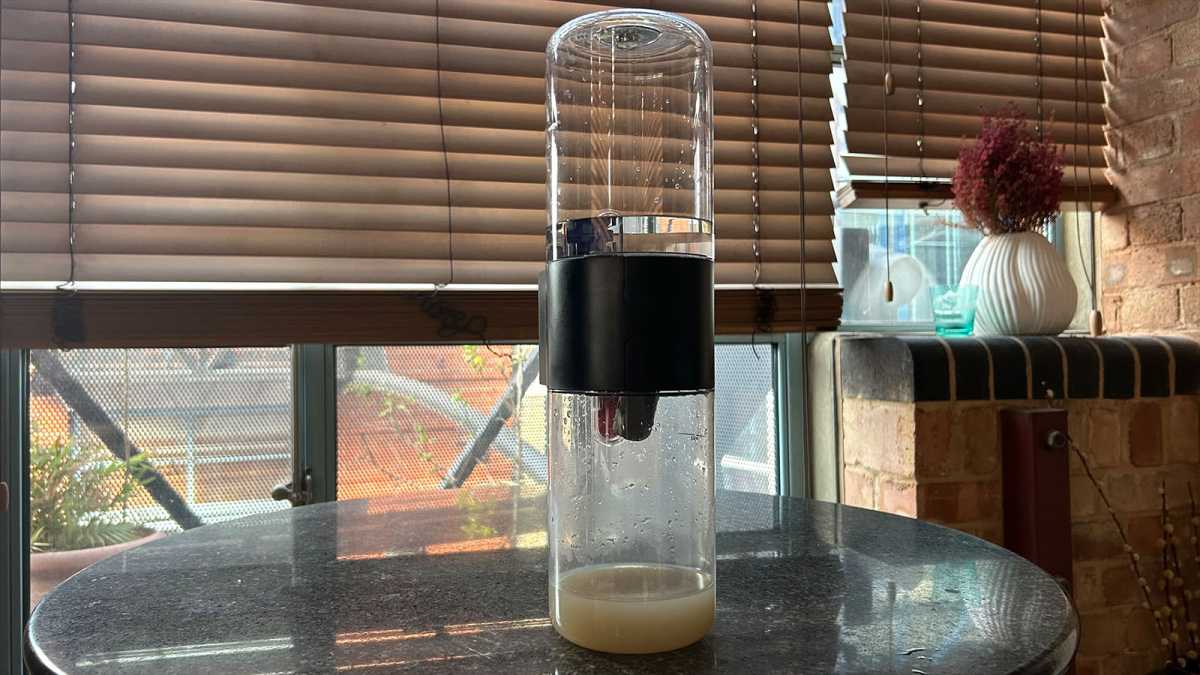
Emma Rowley / Foundry
The WashG1 won’t mop right to the wall. It’ll leave an un-mopped gap of around 1.5cm between the front of the cleaner and the wall. However, along the right-hand side is an edge mopping system, which will clean right up to the wall.
As it’s only along one side, this does mean a bit of extra maneuvering, especially if you have an oddly shaped room.
But it’s no use in corners. If you’re used to a soft mop, which you can squash into corners, it’s simply not as good. But the edge mopping is considerably better than what’s on offer from most rival motorized wet floor cleaners.
After the bedroom, I moved on to the bathroom and kitchen. As the floors needed a bit more attention, I switched up to the second water level. The bathroom tiles and vinyl kitchen floor came up shiny, with very little effort and in even less time.
Then it was on to stain testing. In floor care, there’s a standard test for wet floor cleaners: dried-on tartar sauce, mustard and coffee. In typical Dyson fashion, its engineers decided that this wasn’t sufficient for all the types of spills a cleaner would need to tackle, so they developed their own tests, for products including cosmetics and toiletries.
To test their testing, I streaked my kitchen floor with grainy mustard, moisturiser, foundation, toothpaste, and sticky balsamic glaze, and left the mess on the floor to dry for a couple of hours.
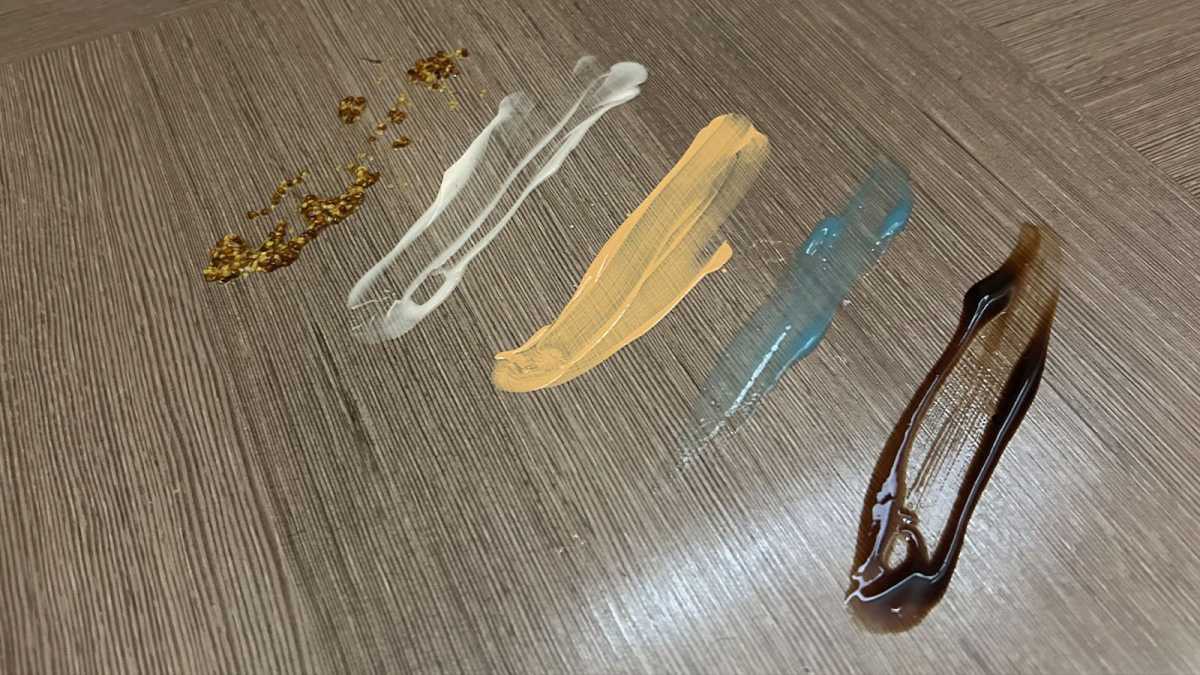
Emma Rowley / Foundry
One sweep on the second water setting removed most of the mess, and it only took a couple more swipes to eradicate its last traces. The WashG1’s cleaning power was seriously impressive.
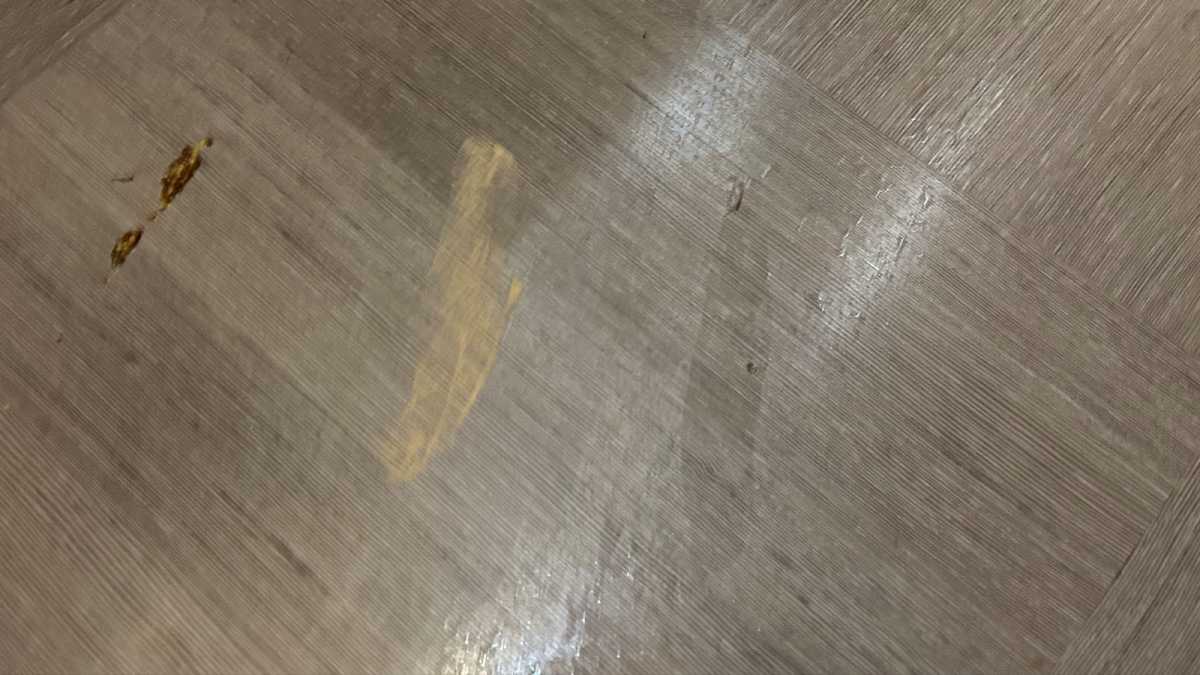
Emma Rowley / Foundry
Still, there are a couple of things the WashG1 can’t do. It’s not a steam cleaner and, as you can’t use it with very hot water or bleach, you won’t be able to sanitise your floors with it. If needed, you can use it with a small amount of detergent, but I didn’t find that necessary during testing.
Once you’ve finished cleaning, it’s time to clean the cleaner. Emptying the dirty water tank is easy, and you won’t find yourself pulling strands of hair from the water.
But that’s because hair and debris is either caught on the rollers or in the debris tray. After a big clean, you pop out the tray and rollers for cleaning.
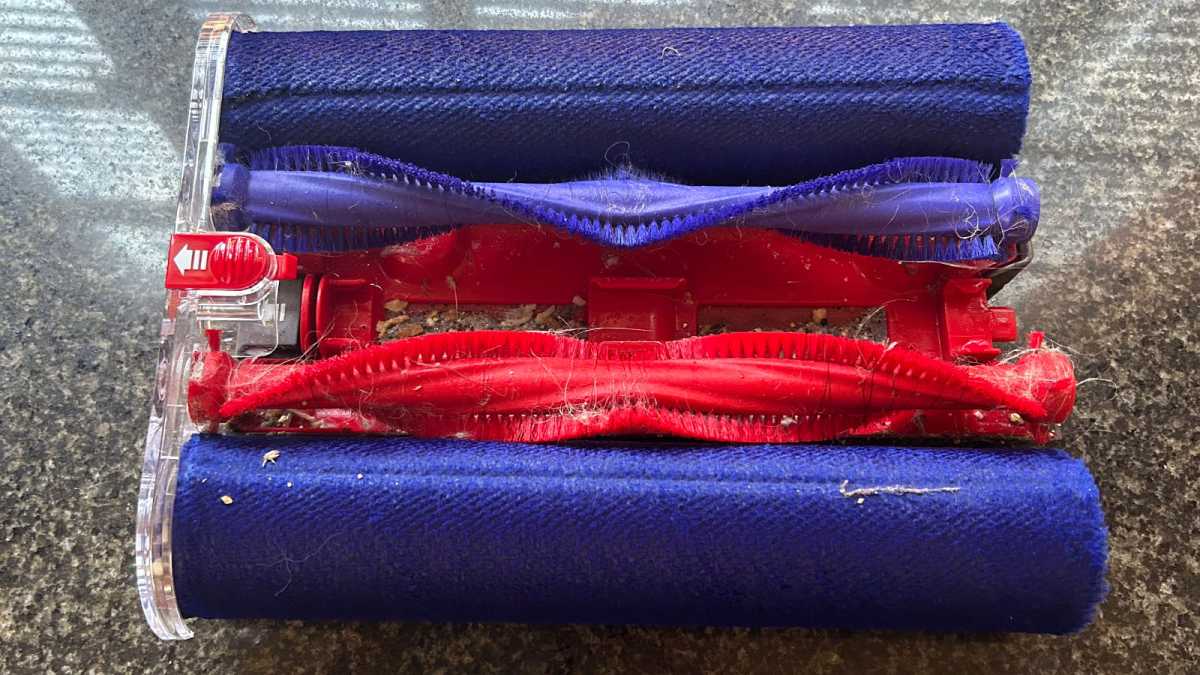
Emma Rowley / Foundry
I won’t lie: this is a bit of a grim job. Even if you tap the tray into the bin, small bits of wet matter will still be stuck to it and no one will be removing them but you.
I also found that long strands of hair had wrapped around the inner brush bars and needed to be pulled or cut away. If you don’t do this regularly, the hair will compress them and reduce their ability to flick debris away.
The rollers have a cleaning life or 25 hours, so you’ll need to replace them regularly. This could wind up being a fair investment if you use the WashG1 as your main cleaner. Rollers are not yet for sale in the spare parts section of the Dyson website, so we don’t yet know how much replacements will cost.
Finally, when you return the WashG1 to its stand, you can start the automatic cleaning programme, which will wash the dirty water from the rollers. It only takes 140 seconds and is much quieter than most such programmes.
The last thing to mention is that, if you have carpeted areas in your home, you’ll need to lift the WashG1 over them if it’s damp. Even I, a weakling, could do this with one hand.
We weren’t able to test the WashG1 for as long as we usually like to before it launched, so we’ll continue to use it and update this review as needed.
Price and availability
The WashG1 is not yet available in the US, but it’ll be priced at $699.99 when it’s released. We believe that this will be in September, but we’re awaiting confirmation from Dyson.
Meanwhile, the WashG1 is available from from Dyson UK for £599. This makes it among the most expensive of the wet vacuums we’d recommend. You can get a very good hard floor cleaner for much less. You’ll find the best option for you in our wet and dry vacuums round-up.
But it’s hard to deny that the WashG1 is one of the best. If you have a lot of hard flooring, it may be worth it.
Dyson fans who want a complete floor cleaning system should check out our review of the Dyson V15s Submarine, a modular stick vacuum which has a wet floor cleaning head, as well as all the other cleaning attachments and features of a high-end Dyson cordless vacuum.
Should you buy the Dyson WashG1?
The WashG1 isn’t for everyone. If you have a mix of hard flooring and carpet, we’d direct you to the Dyson V15s Submarine.
But if you have all, or almost all, hard sealed flooring at home, it could be the floor cleaner for you: it’s fast to use, maneuverable and effective.
You might still want to keep a traditional vacuum to hand for all the dusting jobs around your home, but the WashG1 means you won’t need to vacuum and mop separately. The time saving alone may well make the outlay worth it.
This review was first published on Tech Advisor, our sibling site.









